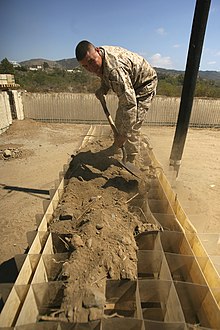



Cellular confinement systems (CCS)—also known as geocells—are widely used in construction for erosion control, soil stabilization on flat ground and steep slopes, channel protection, and structural reinforcement for load support and earth retention.[1] Typical cellular confinement systems are geosynthetics made with ultrasonically welded high-density polyethylene (HDPE) strips or novel polymeric alloy (NPA)—and expanded on-site to form a honeycomb-like structure—and filled with sand, soil, rock, gravel or concrete.[2][3]
- ^ Geosynthetics in landscape architecture and design Archived 2015-02-14 at the Wayback Machine
- ^ State of California Department of Transportation, Division of Environmental Analysis, Stormwater Program. Sacramento, CA."Cellular Confinement System Research." 2006.
- ^ Managing Degraded Off-Highway Vehicle Trails in Wet, Unstable, and Sensitive Environments Archived October 15, 2008, at the Wayback Machine, US Department of Agriculture in conjunction with USDOT, Federal Highway Administration. Page 28. October 2002.
© MMXXIII Rich X Search. We shall prevail. All rights reserved. Rich X Search
